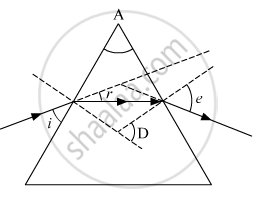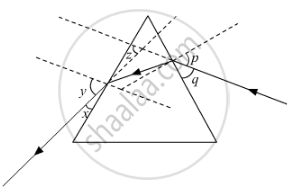Advertisements
Advertisements
Question
What happens when a ray of ordinary light is passed through a triangular glass prism?
Solution
When a ray of ordinary light is passed through a triangular glass prism, the light splits into a spectrum of seven colours. This splitting of light into its constituent colours is called dispersion of light. The role of the prism is to separate the seven colours of the white light.
APPEARS IN
RELATED QUESTIONS
In the following diagram the correctly marked angles are :

(a) ∠A and ∠e
(b) ∠i, ∠A and ∠D
(c) ∠A ∠r and ∠e
(b) ∠A ∠r and ∠D
Study the following ray diagram:

In this diagram, the angle of incidence, the angle of emergence and the angle of deviation respectively have been represented by
(A) y, p, z
(B) x, q, z
(C) p, y, z
(D) p, z, y
Out of the following, the colour of light having the maximum wavelength is:
(a) violet
(b) indigo
(c) green
(d) orange
The speed of light in air or vacuum is
A ray of white light falls on a prism. Draw a ray diagram to show that the prism disperses the white light.
What do you understand by the term spectrum? Name the various colours present in the spectrum of sunlight.
Draw a labelled diagram: Dispersion of light through a prism.
Suggest one way, in each case, by which we can detect the presence of Infrared radiations.
Observe the given figure and answer the following questions.

- Which colour light rays bend most?
- Which colour light rays bend least.
- What is the wavelength of violet light rays?
In dispersion, the color of light that will bend more is ______.
